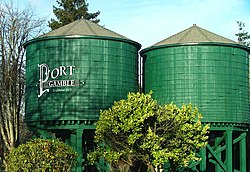Port Gamble, Mill Town
|
Port Gamble Historic District
|
|

Water towers in Port Gamble.
|
|
| Location | Port Gamble, Washington |
|---|---|
| Coordinates | 47°51′15″N 122°35′02″W / 47.85417°N 122.58389°WCoordinates: 47°51′15″N 122°35′02″W / 47.85417°N 122.58389°W |
| Built | 1853 |
| Architectural style | Greek Revival, Late Victorian |
| NRHP Reference # | 66000746 |
| Significant dates | |
| Added to NRHP | November 13, 1966 |
| Designated NHLD | November 13, 1966 |
Port Gamble is an unincorporated community and census-designated place (CDP) on the northwestern shore of the Kitsap Peninsula in Kitsap County, Washington, United States. It is also a small, eponymous bay, along which the community lies, near the entrance to Hood Canal. The unincorporated communities of Port Gamble and Little Boston, part of Kitsap County, lie on either side of the mouth of this bay. The Port Gamble Historic District, a U.S. National Historic Landmark, covers one of the nation's best-preserved western lumber towns. The population was 916 at the 2010 census.
The community of Port Gamble has a wide range of shops from antiques to a tea shop to an old-fashioned general store. It is a popular tourist destination, due to its location near Bremerton, Port Townsend, Bainbridge Island, and Seattle and its downtown. Port Gamble is also home to the grave of Gustave Englebrecht, the first U.S. Navy sailor to die in the Pacific.
Gamble Bay was named by the Wilkes Expedition in 1841. The source of the name is unclear. Wilkes often named places after historical figures, and speculation centers on Lt. Col. John M. Gamble, an illustrious figure in the War of 1812; or U.S. Navy Lt. Robert Gamble, an officer aboard the frigate USS President wounded in an exchange with the HMS Belvedira. But the name may have had a more prosaic origin. Wilkes's published account of the expedition omits mention of either Gamble but does say that a lieutenant's survey party "[o]n entering [Hood’s] canal [at what would become Gamble Bay] camped near some Suquamish Indians who had received as visitors a party of fifty Clalams, by appointment to gamble for blankets: they continued their games throughout the night.”
...
Wikipedia

